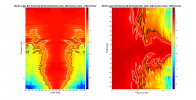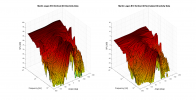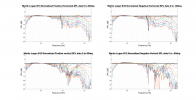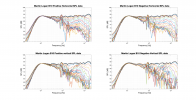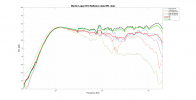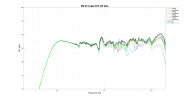This is a review, listening tests, equalization and detailed measurements of the Martin Logan B10 bookshelf speaker. It was kindly sent to me by a member and also loaned one by the company. It costs US $600 each.

The B10 has a gorgeous glossy piano black finish. That is complimented by the best treatment of an AMT tweeter I have seen, giving the front a nice black finish. The impression is quite positive giving the feeling of a luxury in a small package. Back panel sports custom binding posts which I wish were color coded:

The measurements you are about to see are performed on Klippel Near-field Scanner (NFS). It produces anechoic measurements at far field per CEA/CTA-2034 standard. If you are new to my tests, please watch this video on how to understand speaker measurements.
Reference axis was the center of the tweeter although I also computed the results for the rim of the woofer but made no difference.
Martin Logan B10 Speaker Measurements
As usual we start with our anechoic speaker measurements:

At macro level, the response is pretty much flat. We have one peak at around 900 Hz which you will repeatedly see in measurements and slight rising high frequencies from 3 kHz on. Despite sporting a waveguide, there is still some directivity mismatch as the woofer beam gets too narrow before the tweeter takes over and widens it. This directivity error has a fair impact on the tonality of the early/important/loudest reflections from the room:

Let's dissect this into horizontal and vertical reflections:

While non-coaxial 2-ways have some dip vertically, here that is exaggerated and then combined with a less severe one horizontally. The two put together create a broad deviation from netural:

Or is the problem that the treble response is too rich? Your answer will determine which way you draw the regression line: A or B. Audible symptoms will be different to be sure. We will come back to this in listening test section of the review.
Back to our 900 Hz resonance, we clearly see that when we make close in measurements of the port in the back:

There is also another at double its frequency but its level is lower so not much impact. Fortunately the port is in the back so it is not as audible especially if you pull the speaker out from the wall (or use an absorber there).
For such a small speaker, distortion is very well managed:


Notice the trough in distortion indicated by the arrow as the tweeter takes over, relieving the woofer. That makes me think if the crossover point for the tweeter could have been lower which would have also helped potentially with the directivity error. Still, I take the ultra low distortion in that region where our hearing is most sensitive.
Impedance dips to 3.6 ohm which is low but that is typical of modern speakers:

Horizontal beamwidth is 60 degrees in either direction which again is typical:


Vertically we have the really deep dip as you get off angle so better listen at tweeter height lest you want to make the directivity error even worse:

Waterfall shows what we already know as far as resonances:

And as usual, step response tells us little:

Martin Logan B10 Listening Tests and Equalization
Previous review by Erin talked about speaker exaggerating lisping. That didn't match my listening tests. Yes, if a track had lisping, it became more pronounced. But by itself, I didn't hear it doing much of that, if at all. Overall impression of the speaker was that it was doing something right as there was nice fidelity across a lot of my reference tracks. With a speaker that has poor tonality, that percentage drops precipitously. Not here. Yes, there was a bit of brightness but nothing to the point of standing out a lot. Still, I thought I pull that down to see what happens:

The shelving filtering did NOT at all have the expected result. It made the speaker sound dull resulting in my preferring the stock result better due to that. I played around with that filter for 15 to 20 minutes but no matter what I did, it just didn't improve fidelity. So I went after pulling down that resonance. The result there was quite subtle due to high Q (narrowness) of the filter. But it managed to take out a bit of harshness.
As is typical of many speakers, there is a hump around 100 Hz which is close to a room mode I have. That causes a track or two to sound boomy. So I dialed in my usual filter there. Counterintuitively, that improved bass response in that the sound was not only more tight, but also less harsh. My explanation for that is the we are reducing spray of harmonic distortion from the woofer which travels to high frequencies.
With the above two filters in place, the fidelity was improved slightly but still something was not optimal. I went back and forth with my Revel Salon 2 and M106 and M16 bookshelves I have on hand for this type of testing. Both Salon 2 and M16 had a tonality balance that I was not hearing in B10.
I then looked at the PIR response:
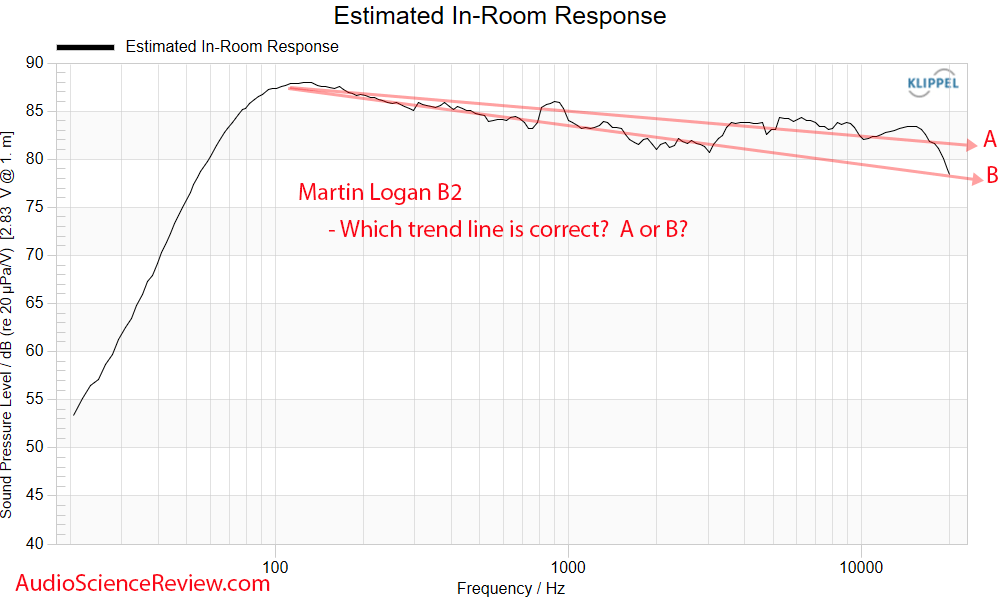
Even though we think directivity errors are not correctable, research into room EQ shows that it is worthwhile trying to correct them. That would call for line A to be correct, needing to fill in the region between 1 and 3 kHz. This resulted in yellow filter #4. I tested this by itself and it nicely increased instrument separation (much like I hear in headphones with the same problem) with better fidelity overall.
While I really like the effect of the yellow filter on lower treble, I thought speaker sounded a bit bright. Now putting in the shelving filter did the job bringing in the highs in balance.
I spent the next half hour tuning the last two filters and where I got them was optimal across large number of reference tracks.
Despite the plurality of filters, the overall effect is subtle but bested the stock tuning which now sounded a bit dull. Performance was very enjoyable across every reference track I throw at the B10.
On sub-bass performance, those frequencies were reproduced but with mild amount of distortion which I like. Techno tracks though lacked enough bass response so you should consider getting a sub to go with this speaker.
Conclusions
One likes to think that after testing some 300 speaker, it would be walk in the park to analyze the performance of a speaker like B10. That was not the case. Even though measurements clearly show a couple of design compromises, figuring out their significance and audible impact was quite non-trivial. I spent more time evaluating this speaker in listening section than many others. I think this has partially to do with directivity error which is harder to get the pulse of, and the goodness of very low distortion speaker in 2 to 5 kHz -- something that keeps reminding you that this speaker is doing something right.
So where we land is that we have a gorgeous looking speaker that has a good stock sound in my opinion but can be improved to be near reference quality with some EQ help.
I am going to recommend the Martin Logan B10 speaker.
Manufacturer Specifications:
Dimensions (H x W x D, with feet) 12-1/2” x 7” x 9-3/4” 31.8cm x 17.8cm x 24.8cm
Frequency Response: 56 Hz - 25 kHz ± 3 dB
Tweeter Dispersion (horizontal x vertical); 90° x 90°
Recommended Amplifier Power: 20 - 200 watts
Sensitivity: 92 dB
Impedance: 5 ohms
High Frequency Driver: 1” x 1.4” (2.6 x 3.6cm) Gen2 Obsidian Folded Motion Tweeter with 9.2 in2 (59.4 cm2) diaphragm
Crossover Frequency: 2,370 Hz (2-way)
Mid-Frequency Drivers: 5.5” (14cm) Woven Fiberglass cone with cast polymer basket. Non- resonant asymmetrical chamber format. Unibody cone construction.
Cabinet: Rear Ported
Binding Post Inputs: Custom 5-way binding posts
Weight:14.5lbs / 6.6kg
Finish: Gloss Black, Walnut, and Satin White
----------
As always, questions, comments, recommendations, etc. are welcome. Click here if you have some audio gear you want me to test.
Any donations are much appreciated using: https://www.audiosciencereview.com/forum/index.php?threads/how-to-support-audio-science-review.8150/
The B10 has a gorgeous glossy piano black finish. That is complimented by the best treatment of an AMT tweeter I have seen, giving the front a nice black finish. The impression is quite positive giving the feeling of a luxury in a small package. Back panel sports custom binding posts which I wish were color coded:
The measurements you are about to see are performed on Klippel Near-field Scanner (NFS). It produces anechoic measurements at far field per CEA/CTA-2034 standard. If you are new to my tests, please watch this video on how to understand speaker measurements.
Reference axis was the center of the tweeter although I also computed the results for the rim of the woofer but made no difference.
Martin Logan B10 Speaker Measurements
As usual we start with our anechoic speaker measurements:
At macro level, the response is pretty much flat. We have one peak at around 900 Hz which you will repeatedly see in measurements and slight rising high frequencies from 3 kHz on. Despite sporting a waveguide, there is still some directivity mismatch as the woofer beam gets too narrow before the tweeter takes over and widens it. This directivity error has a fair impact on the tonality of the early/important/loudest reflections from the room:
Let's dissect this into horizontal and vertical reflections:
While non-coaxial 2-ways have some dip vertically, here that is exaggerated and then combined with a less severe one horizontally. The two put together create a broad deviation from netural:
Or is the problem that the treble response is too rich? Your answer will determine which way you draw the regression line: A or B. Audible symptoms will be different to be sure. We will come back to this in listening test section of the review.
Back to our 900 Hz resonance, we clearly see that when we make close in measurements of the port in the back:
There is also another at double its frequency but its level is lower so not much impact. Fortunately the port is in the back so it is not as audible especially if you pull the speaker out from the wall (or use an absorber there).
For such a small speaker, distortion is very well managed:
Notice the trough in distortion indicated by the arrow as the tweeter takes over, relieving the woofer. That makes me think if the crossover point for the tweeter could have been lower which would have also helped potentially with the directivity error. Still, I take the ultra low distortion in that region where our hearing is most sensitive.
Impedance dips to 3.6 ohm which is low but that is typical of modern speakers:
Horizontal beamwidth is 60 degrees in either direction which again is typical:
Vertically we have the really deep dip as you get off angle so better listen at tweeter height lest you want to make the directivity error even worse:
Waterfall shows what we already know as far as resonances:
And as usual, step response tells us little:
Martin Logan B10 Listening Tests and Equalization
Previous review by Erin talked about speaker exaggerating lisping. That didn't match my listening tests. Yes, if a track had lisping, it became more pronounced. But by itself, I didn't hear it doing much of that, if at all. Overall impression of the speaker was that it was doing something right as there was nice fidelity across a lot of my reference tracks. With a speaker that has poor tonality, that percentage drops precipitously. Not here. Yes, there was a bit of brightness but nothing to the point of standing out a lot. Still, I thought I pull that down to see what happens:
The shelving filtering did NOT at all have the expected result. It made the speaker sound dull resulting in my preferring the stock result better due to that. I played around with that filter for 15 to 20 minutes but no matter what I did, it just didn't improve fidelity. So I went after pulling down that resonance. The result there was quite subtle due to high Q (narrowness) of the filter. But it managed to take out a bit of harshness.
As is typical of many speakers, there is a hump around 100 Hz which is close to a room mode I have. That causes a track or two to sound boomy. So I dialed in my usual filter there. Counterintuitively, that improved bass response in that the sound was not only more tight, but also less harsh. My explanation for that is the we are reducing spray of harmonic distortion from the woofer which travels to high frequencies.
With the above two filters in place, the fidelity was improved slightly but still something was not optimal. I went back and forth with my Revel Salon 2 and M106 and M16 bookshelves I have on hand for this type of testing. Both Salon 2 and M16 had a tonality balance that I was not hearing in B10.
I then looked at the PIR response:
Even though we think directivity errors are not correctable, research into room EQ shows that it is worthwhile trying to correct them. That would call for line A to be correct, needing to fill in the region between 1 and 3 kHz. This resulted in yellow filter #4. I tested this by itself and it nicely increased instrument separation (much like I hear in headphones with the same problem) with better fidelity overall.
While I really like the effect of the yellow filter on lower treble, I thought speaker sounded a bit bright. Now putting in the shelving filter did the job bringing in the highs in balance.
I spent the next half hour tuning the last two filters and where I got them was optimal across large number of reference tracks.
Despite the plurality of filters, the overall effect is subtle but bested the stock tuning which now sounded a bit dull. Performance was very enjoyable across every reference track I throw at the B10.
On sub-bass performance, those frequencies were reproduced but with mild amount of distortion which I like. Techno tracks though lacked enough bass response so you should consider getting a sub to go with this speaker.
Conclusions
One likes to think that after testing some 300 speaker, it would be walk in the park to analyze the performance of a speaker like B10. That was not the case. Even though measurements clearly show a couple of design compromises, figuring out their significance and audible impact was quite non-trivial. I spent more time evaluating this speaker in listening section than many others. I think this has partially to do with directivity error which is harder to get the pulse of, and the goodness of very low distortion speaker in 2 to 5 kHz -- something that keeps reminding you that this speaker is doing something right.
So where we land is that we have a gorgeous looking speaker that has a good stock sound in my opinion but can be improved to be near reference quality with some EQ help.
I am going to recommend the Martin Logan B10 speaker.
Manufacturer Specifications:
Dimensions (H x W x D, with feet) 12-1/2” x 7” x 9-3/4” 31.8cm x 17.8cm x 24.8cm
Frequency Response: 56 Hz - 25 kHz ± 3 dB
Tweeter Dispersion (horizontal x vertical); 90° x 90°
Recommended Amplifier Power: 20 - 200 watts
Sensitivity: 92 dB
Impedance: 5 ohms
High Frequency Driver: 1” x 1.4” (2.6 x 3.6cm) Gen2 Obsidian Folded Motion Tweeter with 9.2 in2 (59.4 cm2) diaphragm
Crossover Frequency: 2,370 Hz (2-way)
Mid-Frequency Drivers: 5.5” (14cm) Woven Fiberglass cone with cast polymer basket. Non- resonant asymmetrical chamber format. Unibody cone construction.
Cabinet: Rear Ported
Binding Post Inputs: Custom 5-way binding posts
Weight:14.5lbs / 6.6kg
Finish: Gloss Black, Walnut, and Satin White
----------
As always, questions, comments, recommendations, etc. are welcome. Click here if you have some audio gear you want me to test.
Any donations are much appreciated using: https://www.audiosciencereview.com/forum/index.php?threads/how-to-support-audio-science-review.8150/
Attachments
Last edited by a moderator:

